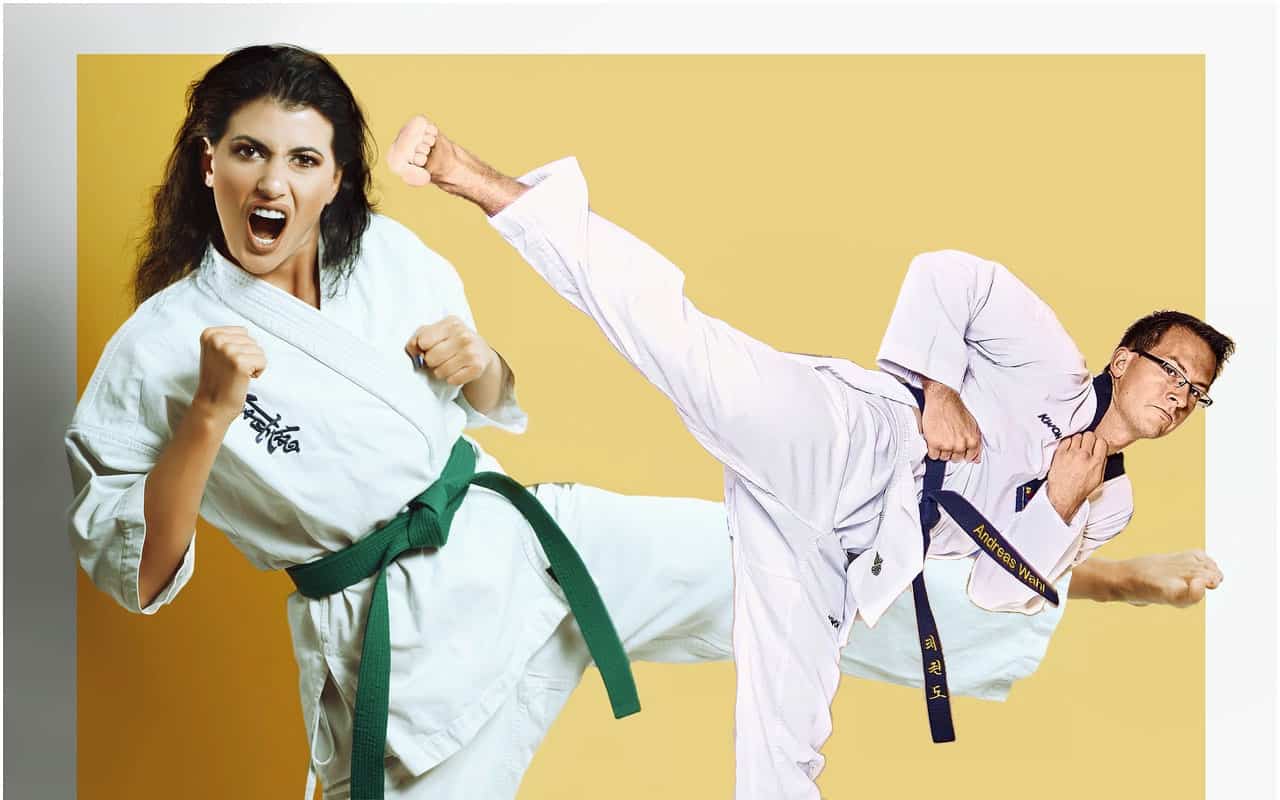Out of the dozens of martial arts styles and the dozens of substyles, it can often be complicated to find the best one. Just like it would be hard for the average person on the street to judge the best wine in the world (since it also has types and subtypes), it is also hard for them to judge the best martial art. Add to that the weird Asian names of these fighting styles, and you have got yourself in quite a situation. You can type in all of these terms separately into Google and do your research, or you can let us do it for you. In our series of articles comparing different martial arts and karate styles, today we bring you Shotokan vs Taekwondo. We will dive into the similarities and the differences between these popular and famed martial arts.
The main difference between Shotokan Karate and Taekwondo, aside from their history and some basic concepts, is that while Shotokan is a relatively balanced striking art (it uses arms and legs almost equally), the majority of Taekwondo is made up of kicking techniques.
It isn’t just the techniques or the specific striking methods that differ, though. The history of these martial ars is vastly different, and so are their outlooks on life and their philosophy. In this article, after hours of researching and synthesizing that with some personal experience, we will present to you a mostly objective comparison of these two amazing martial arts. Read on if you’re interested!
What are the Differences Between Shotokan and Taekwondo?
Although the names of both martial arts sound mysterious to the average Western person, and they might seem like they cover similar concepts and activities, these two martial arts are actually quite different. On a less serious note, these styles are so different, that it would even be visible on the screen while watching a film, which means there is a true distinction between the two. On a more serious note, however, the philosophy and the techniques used in the two arts are vastly different, and an article ten times as long as this one would be needed to analyze all the differences, and that would still be scratching the surface.
In this text, we will run over the main differences and some of the history, so if you want more information on either art, we have compared them to other karate styles and even combat styles like Krav Maga or Boxing, so feel free to check those out if you are interested.
Starting with the history of Shotokan, a name has to be mentioned, which is probably the number one (or maximum number two) Eastern name you will hear in any presentation about Japanese martial arts or Eastern combat styles in general. This name is Gichin Funakoshi. He was one of the most important martial artists of the 20th century (born: 1868.), responsible for singlehandedly popularizing the art to the extent that his style, Shotokan, became the Japanese national “response” to Western boxing. Jigoro Kano, the legendary founder of Judo, and the most important martial artist in Japan at the time, also viewed Gichin’s karate as a great addition to Japanese culture, and he also helped spread it, leveraging his political influence.
Shotokan karate is a relatively brute, force-vs-force type of martial art. It didn’t retain many circular and soft motions from Chinese martial arts like Goju-Ryu did, for example (click here to read Shotokan vs Goju-Ryu), and is heavily centered around strikes like kicking and punching and blocking. Traditionally, it also involved some grappling and joint-lock techniques, but those seemed to fade away the more distance was put between the dojo and Okinawa, the birthplace of both Funakoshi and also karate in general.
Taekwondo is a martial art or combative sport, developed during the 1940s and 1950s by Korean martial artists (the main one being Choi Hong Hi) with experience in a number of different martial arts such as karate, Chinese martial arts, and indigenous Korean martial arts such as Taekkyon and Gwonbeop. The oldest governing body which is still active for Taekwondo is the Korea Taekwondo Association, formed in the year 1959. It was a result of a collaborative effort by the main representatives’ ad masters from the nine Kwans, or martial arts schools, in Korea.
Taekwondo is mostly characterized by kicks. This statement, however shallow compared to the original contents of Taekwondo, is actually quite true for most schools. There is a central set of ideas in Taekwondo called the Theory of Power. These were put together by Choi Hong Hi, the general who created Taekwondo. These principles outline a couple of concepts that Choi observed when examining martial arts. One of the most important of these is the Speed element, which states that according to Newtonian physics as well as observation, the power of a strike grows exponentially with the speed of the strike, whereas it only grows linearly with the mass of the striking object which is in motion.
Both of these concepts are used in Taekwondo, and if you combine them and see which body parts of the human body can be used the best in these terms, it is undoubtedly the legs. Kicks can reach insane speeds if practiced, and with the help of jumping and putting the hip into the motion, large amounts of extra mass can be put behind the strike, making it ever the more strong, especially compared to a fist strike.
Which is Better for Self-defense: Shotokan or Taekwondo?
The reason most people train in martial arts is to learn how to defend themselves and their loved ones effectively. This is why it is likely that the most searched topic concerning martial arts on the internet is how one martial art fares against another one. We will try to compare Taekwondo and Shotokan in terms of self-defense effectiveness.
Even though this is a pretty close call, we would suggest Shotokan be the better martial art to learn for self-defense. The reason for this is that it is more well-rounded, whereas Taekwondo tends to be very kicking-based, which, though not necessarily ineffective, isn’t the best option for the streets.
Most untrained people, unfortunately, when thinking of a street fighting scenario, think of it as a movie scene. The issue is, it never works that way. Just because you can throw an awesome spinning hook kick doesn’t mean you can use it on the street. Most street fights are quite close-range and are also really rough. If you are a Taekwondo practitioner, you can win a fight, mostly if you keep your opponent at a kicking distance and if you don’t let them close in on you, in which case, you have less of a chance, seeing as you aren’t that well trained with your arms.
Shotokan on the other hand deals with kicking, punching, and blocking (sometimes grappling as well), both long- and short-range. This puts it at an advantage since, in a street fight, the person who wins is either the one who hits first or the one who is more comfortable in as many places as possible (close-range, long-range, ground). If you are preparing for the street, it isn’t a good idea to have a very one-dimensional approach, and with Taekwondo, that is exactly what you are doing.
Again, Taekwondo is also effective, and a well-timed roundhouse kick to the side or even the leg can cripple an opponent when they are approaching, but unfortunately, you usually have only one chance to throw a good kick on the street, after that, it is either punches or grappling. Because of this, Shotokan wins in our self-defense effectiveness analysis.
Which One Should You Choose: Shotokan or Taekwondo?
When it comes down to making the decision, there are a couple of things that might have missed your gaze, and we will try pointing them out to you in order to help you make the best decision possible. Clearly, much of the decision you make will be based on which style impresses you in Youtube videos, but there are other, crucial things to take into consideration, for your own good.
The most important of all is to check the dojo you plan on training in. Let’s assume that there are both Shotokan and Taekwondo dojos near you, so availability isn’t an issue for you. Now, the most important step is not deciding what you like, but visiting the dojo for a practice session if they allow it. Most dojos offer 1 free training session for you to get a feel for both the dojo and the art itself, and this is your chance to examine your potential dojo. Make sure they aren’t scammer-like, make sure the atmosphere is friendly instead of competitive, and also make sure that you feel the connection to the dojo, otherwise you won’t enjoy the classes.
Vibes, scams, and authenticity aside, which one should you choose? Well, we value self-defense a lot, and seeing as martial arts were developed for that purpose, our choice lies with Shotokan Karate. Taekwondo is an awesome art that you can definitely enjoy and get a lot out of, but if you are like us and you prioritize self-defense, Shotokan is your best bet out of the two.

